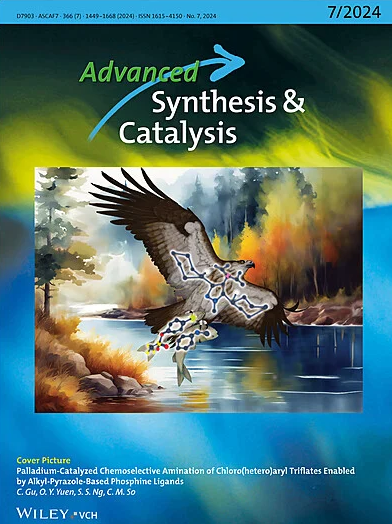铜催化合成功能化二元醚的双齿 NHC 配体
IF 4.4
2区 化学
Q2 CHEMISTRY, APPLIED
引用次数: 0
摘要
二芳基和杂芳基醚是药物开发和农用化学品中重要而常见的基团。在此,我们介绍一种铜催化苯酚与芳基卤化物芳基化的催化体系。双齿 N-heterocyclic carbene 配体提供了一个定义明确的催化体系,可在有效的偶联反应中实现低铜负载(0.5 mol% Cu 或更低)。我们开发了芳基碘化物和芳基溴化物的反应范围,该范围对官能团具有耐受性,并制备了具有类铅特性的双芳基醚库。研究表明,过量配体(1:3 比例)的存在是防止催化剂降解的最佳条件,这可能是通过避免配体的解络合作用实现的。预先形成的铜络合物的催化结果也证明了这一点。对反应动力学进行了研究,结果表明,在所开发的条件下,铜的反应动力学为一阶,这支持了一种定义明确的催化剂物种;苯酚和芳基碘化物的反应动力学为一阶,而碱的反应动力学为零阶。使用明尼苏达 MN15-L 参数化方法进行的计算研究支持氧化加成-还原消除途径。还原消除将限制转化率,并通过亲密的离子对中间体发生。本文章由计算机程序翻译,如有差异,请以英文原文为准。
Bidentate NHC‐Containing Ligands for Copper Catalysed Synthesis of Functionalised Diaryl Ethers
Diaryl and heteroaryl ethers are important and common motifs in drug discovery and agrochemicals. Here we present a catalytic system for the copper catalysed arylation of phenols with aryl halides. Bidentate N‐heterocyclic carbene ligands provide a well‐defined catalytic system that enable low loading of copper in effective coupling reactions (0.5 mol% Cu or lower). The reaction scope of aryl iodides and aryl bromides is developed, that is tolerant of functional groups and a library of biaryl ethers with lead‐like properties is prepared. The presence of excess ligand (in a 1:3 ratio) is shown to be optimal to prevent catalyst degradation, presumably by avoiding decomplexation of the ligand. This is also supported by the catalytic results obtained with pre‐formed copper complexes. The kinetics of the reaction are examined and shown to be first order in copper, supportive of a well‐defined catalyst species, first order in phenol and aryl iodide, and zero order in base under the developed conditions. Computational studies performed using Minnesota MN15‐L parametrisation method support an oxidative addition–reductive elimination pathway. Reductive elimination would be turnover limiting and occurr through an intimate ion pair intermediate.
求助全文
通过发布文献求助,成功后即可免费获取论文全文。
去求助
来源期刊

Advanced Synthesis & Catalysis
化学-应用化学
CiteScore
9.40
自引率
7.40%
发文量
447
审稿时长
1.8 months
期刊介绍:
Advanced Synthesis & Catalysis (ASC) is the leading primary journal in organic, organometallic, and applied chemistry.
The high impact of ASC can be attributed to the unique focus of the journal, which publishes exciting new results from academic and industrial labs on efficient, practical, and environmentally friendly organic synthesis. While homogeneous, heterogeneous, organic, and enzyme catalysis are key technologies to achieve green synthesis, significant contributions to the same goal by synthesis design, reaction techniques, flow chemistry, and continuous processing, multiphase catalysis, green solvents, catalyst immobilization, and recycling, separation science, and process development are also featured in ASC. The Aims and Scope can be found in the Notice to Authors or on the first page of the table of contents in every issue.
 求助内容:
求助内容: 应助结果提醒方式:
应助结果提醒方式:


